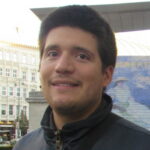Biomolecular changes are prevalent in all aspects of biology. Not only protein folding, but also association and dissociation processes, such as proteins binding to DNA, ligand-binding to receptors, substrate binding/release in enzymatic reactions, and proteins forming multicomponent complexes are basic steps in the living cell. A full molecular understanding in terms of the underlying chemistry and physics is often difficult to achieve due to the sheer complexity of these interactions. Yet, such understanding of living matter is important from a basic science point of view as well as for applications in societal relevant areas such as health, energy and sustainability.
Molecular dynamics (MD) simulation is a robust bottom-up method for describing how protein structure and dynamics follows from molecular interactions. While, in principle, evaluating molecular interactions would require quantum mechanical approaches, in many cases classical force fields already are sufficiently accurate . Indeed, molecular simulation has advanced to a level that it can predict properties,interpret experiments, and test hypotheses for many molecular (bio)systems . However, even when using calsical force fields, all-atom molecular dynamics often demands short time steps (fs), and the timescales and systems sizes that one can reach are limited to milliseconds and nanometres . Many processes in nature take place on much longer timescales, e.g. nucleated phase transitions, chemical reactions, and biomolecular isomerization and assembly often caused by the presence of high internal (free) energy barriers in the molecularsystems .
Protein-DNA interaction

Dr. Jocelyne Vreede
Computational Chemistry Group
Jocelyne Vreede works on conformational transitions in biomolecules, in particular proteins and DNA. Changes in conformation include binding-unbinding transitions, reorientation of specific groups within a biomolecule and large scale changes such as the (un)folding of an alpha-helix. In studying the regulation of transcription, the binding of proteins to DNA, and subsequent rearrangements are important processes relevant for biology. The association of ions to proteins may have a huge effect on the shape of the protein, which is relevant for the stability of enzymes and for the mechanisms of sodium sensing in plants.
Biomolecular isomerisation

Prof. dr. Peter Bolhuis
Computational Chemistry Group
Peter Bolhuis has a long standing interest in biomolecular simulation, and in particular applying path sampling of biomolecular isomerisation.
Enzymatic reactivity

Dr. Bernd Ensing
Computational Chemistry Group
Bernd Ensing works on…
Computational Polypeptide Design

Dr. Ioana M. Ilie
Computational Chemistry Group
Ioana Ilie focusses on the complex interplay between structure and function in macromolecules. In particular, she investigates the conformational changes in proteins associated with neurodegenerative diseases and their aggregates, interactions with membranes, epigenetic modifications and designs peptides to modulate protein activity.
Predicting properties of biopolymers

Dr. Alberto Pérez de Alba Ortíz
Computational Chemistry Group
Alberto Pérez de Alba Ortíz has experience in modelling peptides, proteins, polysaccharides and nucleic acids, particularly with the purpose of finding free energies of mechanistic pathways. Currently, he focuses on designing mechanical properties of biopolymers and in predicting risks of nanoplastics to protein function.